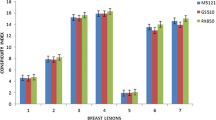Abstract
The purpose of this study was to assess the image quality and the rate of failure of the high-resolution (2,048×1536 pixel) monitors used for primary diagnosis in a filmless radiology department and to analyze the type of problems encountered as well as the action taken to repair the monitors. Data were collected from Picture Archival and Communication System (PACS) service logs to determine rates of monitor adjustment and replacement, the symptoms reported, and the action taken. Additionally, random surveys of the high-resolution monitors were performed using a standard test pattern to assess spatial and contrast resolution in the center and outer corners of the monitors. Analysis of monitor service records showed a high rate of monitor replacement (41% per year) resulting in a relatively short “life expectancy” (defined as average time required before replacement) of 2.4 years. Random surveys of monitor quality using a standard test pattern showed suboptimal image quality in approximately 54% of the monitors with moderate image quality degradation present in at least one region of 27% of the high-resolution monitors, despite our vendor’s quality control program. The results of this study support our subjective impression and those of other colleagues in the PACS community of an unacceptably high monitor failure rate and persistent image quality problems with 2,000 pixel monitors used for primary diagnosis. The relatively high incidence of suboptimal quality monitors suggests that more frequent quality control should be performed using a test pattern particularly given the fact that radiologists often are unable to discern degradation of monitor performance using clinical images. The high incidence of problems with image quality on high-resolution monitors indicates that vendors need to develop better quality control in monitor design and testing. Radiologists should review briefly a test pattern on each monitor at the beginning of each day. A computer program should be incorporated into the PACS, which asks radiologists to evaluate a test pattern and records the results in a central database, which is communicated to the service engineers. Further studies should be evaluated to determine the clinical impact of monitor image degradation, which is relatively easily seen using a test pattern but may be difficult to discern on clinical images. Requests for proposals (RFPs) for PACS and service contracts must specify carefully requirements for monitor image quality and conditions under which the vendor is required to replace these monitors.
Similar content being viewed by others
References
Hangiandreou NJ, Fetterly KA, Felmless JP: Optimization of a contrast-detail-based method for electronic image display quality evaluation. J Digit Imaging 12:60–67 1999
Roehrig H, Willis CE, Damento, MA: Characterization of monochrome CRT display systems in the field. J Digit Imaging 12:152–165, 1999
Hemminger BM, Johnston RE, Rolland JP, et al: Perceptual linearization of video display monitors for medical image presentation. Proc SPIE 2164:222–241, 1994
Reiker GG, Gohel N, Muke E, et al: Quality Monitoring of Soft-copy Displays for Medical Radiography. J Digit Imaging 5:161–167, 1992
Dwyer SJ 3d, Steward BK, Sayre JW, et al: Performance Characteristics and Image Fidelity of Gray-scale. Monitors. Radiographics 12:765–772, 1992
Nawfel RD, Chan KH, Wagenaar DJ, et al: Evaluation of video gray-scale display. Med Phys 19:561–567, 1992
Roehrig, H, Blume H, Ji TL, et al: Performance tests and quality control of cathode ray tube displays. J Digit Imaging 3:134–145, 1990
Tucker DM, McEachern M: Quality assurance and quality control of an intensive care unit picture archiving and communication system. J Digit Imaging 11:180–186, 1998 (suppl 3)
Parsons DM, Kim Y, Haynor DR: Quality control of cathode-ray tube monitors for medical imaging using a simple photometer. J Digit Imaging 8:10–20, 1995
Gray JE: Use of the SMPTE Test Pattern in Picture Archiving and Communication Systems. J Digit Imaging 5:54–58, 1992
Siegel EL, Diaconis JN, Pomerantz S, et al: Making filmless radiology work. J Digital Imaging 8:151–155, 1995
Reiner B, Siegel E, Hooper F, et al: Variation of monitor luminance on radiologist productivity in the interpretation of skeletal radiographs using a picture archiving and communication system. J Digit Imaging 10:176, 1997 (3 suppl 1)
Author information
Authors and Affiliations
Rights and permissions
About this article
Cite this article
Siegel, E.L., Reiner, B.I. & Cadogan, M. Frequency and impact of high-resolution monitor failure in a filmless imaging department. J Digit Imaging 13, 114–118 (2000). https://doi.org/10.1007/BF03168383
Issue Date:
DOI: https://doi.org/10.1007/BF03168383




